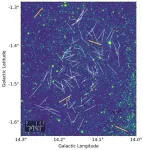(Press-News.org) New Haven, Conn. — The quest for personalized medicine, a medical approach in which practitioners use a patient’s unique genetic profile to tailor individual treatment, has emerged as a critical goal in the health care sector. But a new Yale-led study shows that the mathematical models currently available to predict treatments have limited effectiveness.
In an analysis of clinical trials for multiple schizophrenia treatments, the researchers found that the mathematical algorithms were able to predict patient outcomes within the specific trials for which they were developed, but failed to work for patients participating in different trials.
The findings are published Jan. 11 in the journal Science.
“This study really challenges the status quo of algorithm development and raises the bar for the future,” said Adam Chekroud, an adjunct assistant professor of psychiatry at Yale School of Medicine and corresponding author of the paper. “Right now, I would say we need to see algorithms working in at least two different settings before we can really get excited about it.”
“I’m still optimistic,” he added, “but as medical researchers we have some serious things to figure out.”
Chekroud is also president and co-founder of Spring Health, a private company that provides mental health services.
Schizophrenia, a complex brain disorder that affects about 1% of the U.S. population, perfectly illustrates the need for more personalized treatments, the researchers say. As many as 50% of patients diagnosed with schizophrenia fail to respond to the first antipsychotic drug that is prescribed, but it is impossible to predict which patients will respond to therapies and which will not.
Researchers hope that new technologies using machine learning and artificial intelligence might yield algorithms that better predict which treatments will work for different patients, and help improve outcomes and reduce costs of care.
Due to the high cost of running a clinical trial, however, most algorithms are only developed and tested using a single clinical trial. But researchers had hoped that these algorithms would work if tested on patients with similar profiles and receiving similar treatments.
For the new study, Chekroud and his Yale colleagues wanted to see if this hope was really true. To do so, they aggregated data from five clinical trials of schizophrenia treatments made available through the Yale Open Data Access (YODA) Project, which advocates for and supports responsible sharing of clinical research data. In most cases, they found, the algorithms effectively predicted patient outcomes for the clinical trial in which they were developed. However, they failed to effectively predict outcomes for schizophrenia patients being treated in different clinical trials.
“The algorithms almost always worked first time around,” Chekroud said. “But when we tested them on patients from other trials the predictive value was no greater than chance.”
The problem, according to Chekroud, is that most of the mathematical algorithms used by medical researchers were designed to be used on much bigger data sets. Clinical trials are expensive and time consuming to conduct, so the studies typically enroll fewer than 1,000 patients. Applying the powerful AI tools to analysis of these smaller data sets, he said, can often result in “over-fitting,” in which a model has learned response patterns that are idiosyncratic, or specific just to that initial trial data, but disappear when additional new data are included.
“The reality is, we need to be thinking about developing algorithms in the same way we think about developing new drugs,” he said. “We need to see algorithms working in multiple different times or contexts before we can really believe them.”
In the future, the inclusion of other environmental variables may or may not improve the success of algorithms in the analysis of clinical trial data, researchers added. For instance, does the patient abuse drugs or have personal support from family or friends? These are the kinds of factors that can affect outcomes of treatment.
Most clinical trials use precise criteria to improve chances for success, such as guidelines for which patients should be included (or excluded), careful measurement of outcomes, and limits on the number of doctors administering treatments. Real world settings, meanwhile, have a much wider variety of patients and greater variation in the quality and consistency of treatment, the researchers say.
“In theory, clinical trials should be the easiest place for algorithms to work. But if algorithms can’t generalize from one clinical trial to another, it will be even more challenging to use them in clinical practice,’’ said co-author John Krystal, the Robert L. McNeil, Jr. Professor of Translational Research and professor of psychiatry, neuroscience, and psychology at Yale School of Medicine. Krystal is also chair of Yale’s Department of Psychiatry.
Chekroud suggests that increased efforts to share data among researchers and the banking of additional data by large-scale health care providers might help increase the reliability and accuracy of AI-driven algorithms.
“Although the study dealt with schizophrenia trials, it raises difficult questions for personalized medicine more broadly, and its application in cardiovascular disease and cancer,” said Philip Corlett, an associate professor of psychiatry at Yale and co-author of the study.
Other Yale authors of the study are Hieronimus Loho; Ralitza Gueorguieva, a senior research scientist at Yale School of Public Health; and Harlan M. Krumholz, the Harold H. Hines Jr. Professor of Medicine (Cardiology) at Yale.
END
Quest for personalized medicine hits a snag
2024-01-11
ELSE PRESS RELEASES FROM THIS DATE:
Bridging light and electrons
2024-01-11
When light goes through a material, it often behaves in unpredictable ways. This phenomenon is the subject of an entire field of study called “nonlinear optics”, which is now integral to technological and scientific advances from laser development and optical frequency metrology, to gravitational wave astronomy and quantum information science.
In addition, recent years have seen nonlinear optics applied in optical signal processing, telecommunications, sensing, spectroscopy, light detection and ranging. All these applications involve the miniaturization of devices ...
Climate change spells disaster for termite-loving numbats
2024-01-11
Australia is known for its wonderous and unique wildlife. But, just like the rest of the world, Australia is expected to get even hotter because of climate change. This could spell disaster for many of the marsupials that call the drier regions of the country home as it may get too hot for them to handle. To make things even more difficult, many of these marsupials are endangered thanks to habitat loss and introduced species such as domestic cats and red foxes. Therefore, finding a way to study these animals without disturbing them is critical to ensure their survival. This realisation led Christine Cooper (Curtin University, ...
ACIP releases 2024 Adult Immunization Schedule featuring four new vaccines
2024-01-11
Embargoed for release until 1:00 p.m. ET on Thursday 11 January 2024
Annals of Internal Medicine Tip Sheet
@Annalsofim
Below please find a summary for new article that will be published in of Annals of Internal Medicine. The summary is not intended to substitute for the full articles as a source of information. This information is under strict embargo and by taking it into possession, media representatives are committing to the terms of the embargo not only on their own behalf, but also on behalf of the organization they represent.
-------------------------------------------------
ACIP ...
Thermal vision shows endangered numbats feel the heat of warming climate
2024-01-11
Curtin University research using thermal imaging of numbats in Western Australia has found that during hot weather the endangered animals are limited to as little as ten minutes of activity in the sun before they overheat to a body temperature of greater than 40°C.
Lead author Dr Christine Cooper, from Curtin’s School of Molecular and Life Sciences, said despite using techniques such as raising or flattening their fur to regulate body temperature, numbats were prone to overheating, which was an important consideration for future conservation efforts, particularly given our warming climate.
“Active only during ...
A call for improved CDC communication on adult immunization
2024-01-11
In an editorial in the Annals of Internal Medicine, CUNY SPH Distinguished Lecturer Scott Ratzan, Senior Scholar Ken Rabin, and colleagues call for the Centers for Disease Control and Prevention (CDC) to “raise its persuasive communications game” on adult immunization to clinicians and the public. They argue that disseminating scientific information alone will not suffice in the present environment of disinformation and low trust in public health.
The editorial is in response to the CDC’s ...
JMIR Biomedical Engineering has passed the Scientific Quality Review by NLM for PMC
2024-01-11
JMIR Publications is pleased to announce that JMIR Biomedical Engineering has passed the Scientific Quality Review by the US National Library of Medicine (NLM) for PubMed Central (PMC). This decision reflects the scientific and editorial quality of the journal. All articles published from 2021 onward will be found on PMC and PubMed after their technical evaluation.
Launched in 2016, JMIR Biomedical Engineering is a sister journal of Journal of Medical Internet Research (the leading open-access journal in health informatics), focused on the application of engineering principles, ...
Close encounters of the supermassive black hole kind: tidal disruption events and what they can reveal about black holes and stars in distant galaxies
2024-01-11
At the center of most large galaxies lives a supermassive black hole (SMBH). The Milky Way has Sagittarius A*, a mostly dormant SMBH whose mass is around 4.3 million times that of the sun. But if you look deeper into the universe, there are vastly larger SMBHs with masses that can reach up to tens of billions of times the mass of our sun.
Black holes grow in mass by gravitationally consuming objects in their near vicinity, including stars. It’s a catastrophic and destructive end for stars unlucky enough to be swallowed by SMBHs, but fortunate for scientists who now have an opportunity to probe otherwise-dormant centers of galaxies.
TDEs Light the Way
As the name ...
Study reveals new connection between impaired autophagy and heart failure
2024-01-11
A new study sheds light on how autophagy, the body’s process for removing damaged cell parts, when impaired, can play a role in causing heart failure. The research team led by Dr. E. Dale Abel, chair of the Department of Medicine at UCLA and Dr. Quanjiang Zhang, adjunct assistant professor of medicine at UCLA, identified a signaling pathway that links autophagy to the control of cellular levels of a key coenzyme known as NAD+, which is found in all living cells and is central to how our metabolism works. Researchers say these findings may have implications ...
Exploring dimethylsulfoniopropionate production by freshwater phytoplankton in lake Baikal
2024-01-11
Phytoplankton or microalgae found in the ocean are often known to produce a sulfur-containing chemical called dimethylsulfoniopropionate (DMSP). This organic molecule breaks down to release a strong but sweet-smelling gas called dimethyl sulfide (DMS), which plays a major role in the formation of cloud condensation nuclei and is also associated with the smell of the sea. More importantly, DMSP acts as an osmolyte and thus protects the phytoplankton against the osmotic pressure created by saline water.
Scientists have, however, ...
Our surprising magnetic galaxy
2024-01-11
A team of astronomers including those from the University of Tokyo created the first-ever map of magnetic field structures within a spiral arm of our Milky Way galaxy. Previous studies on galactic magnetic fields only gave a very general picture, but the new study reveals that magnetic fields in the spiral arms of our galaxy break away from this general picture significantly and are tilted away from the galactic average by a high degree. The findings suggest magnetic fields strongly impact star-forming regions which means they played a part in the creation of our own solar system.
It might come as a surprise to ...




